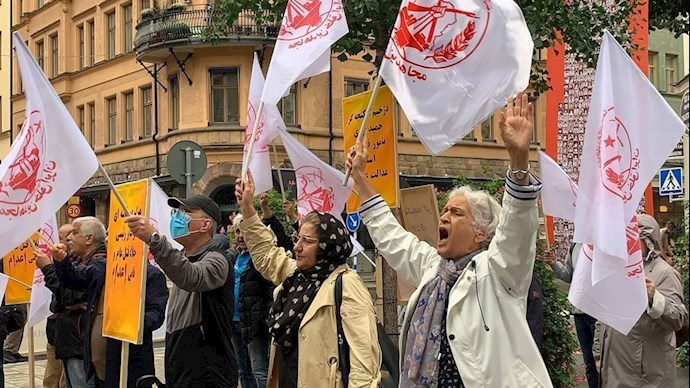Analysis by PMOI/MEK
Iran, August 20, 2021—The historic trial of Hamid Nouri, an Iranian regime torturer, in Sweden is now in its second week. Nouri is being tried for his role in the 1988 massacre of more than 30,000 Iranian political prisoners, most of whom were members and supporters of the People’s Mojahedin Organization of Iran (PMOI/MEK).
Nouri was among the regime’s torturers in Gohardasht prison
The execution of the prisoners was orchestrated at the highest levels of power in the Iranian regime. Then–supreme leader Ruhollah Khomeini personally ordered the slaughter and gave a fatwa, in which he explicitly instructed judiciary and prison authorities to execute all prisoners who remained steadfast in their support for the MEK. At the time, Nouri was among the regime’s torturers in Gohardasht prison, Karaj city.
Since Nouri’s apprehension by Swedish authorities, many witnesses of the 1988 massacre and relatives of the victims have filed complaints against him and other regime authorities. The Iranian regime has resorted to different tactics and threats to prevent Nouri’s trial from taking place or to try to divert focus from the main topic, which is the mass execution of MEK supporters and members.
At the fifth trial of Hamid Nouri, accused of crimes against humanity in Iran in the #1988massacre, a lawyer for the Mojahedin Khalq Organization of #Iran (#MEK/#PMOI)stressed that the term “Massacre” should be used in court to accurately describe executions.#ProsecuteRaisiNow pic.twitter.com/lFepfUfG15
— Iran Freedom (@4FreedominIran) August 20, 2021
However, the court proceedings in the first week alone indicate that the regime has failed in its mission and this trial can set a precedent to bring the regime highest officials to justice for their role in this heinous crime in humanity:
1- The prosecution of Nouri shed light on various aspects of the 1988 massacre. During the trial, witnesses and prosecutors presented documents and provided testimonies that shed light on the crimes of the regime. Excerpts from books written by the survivors were read in court, including a new book that contains the names and particulars of 5,000 executed prisoners. Khomeini’s fatwa was registered as evidence pertaining to the crime being directly targeted at steadfast MEK members. Prosecutors presented a list of 444 prisoners who were executed in Gohardasht prison, where Nouri served at the time.
2- There were so many witnesses who were ready to give testimonies that the court did not have the capacity to bring all of them to the stand. In parallel to the court proceedings, many of the survivors and witnesses of the 1988 massacre were interviewed by different news outlets, which brought international attention to the 1988 massacre.
In the 5th session of the trial of Hamid Nouri,accused of crimes against humanity in #Iran during the #1988massacre,Ms. Sana Sotoudeh,@sana_sutu– delivered a speech.
She demanded that the leaders of the Iranian regime be tried.#ProsecuteRaisiNow@amnestypic.twitter.com/fK3WHA90nM— Iran Freedom (@4FreedominIran) August 20, 2021
3- The trial has not been limited to the role of Nouri in the 1988 massacre. The prosecution team is calling for all the perpetrators and orchestrators of this crime against humanity to summoned and tried. The prosecutor referred to a 2018 report by Amnesty International titled, “Blood-soaked secrets,” and stipulated that the so-called judges who were involved in the 1988 massacre explicitly asked prisoners to state their position on the MEK and anyone who defended support for the Iranian opposition was sent to the gallows.
4- The court also quoted Khomeini’s heir-apparent Ayatollah Hossein-Ali Montazeri as saying that the “MEK are not people, they are a way of thought. Thought must be answered with thought, not with killing.” This registration of this fact further proves that the 1988 executions were a systematic annihilation of people with a specific mindset, which can only be described as genocide.
5- The constant presence and rallies of the families of the victims and witnesses outside the court, their interviews and speeches, and all their activities have turned Nouri’s trial into the tribunal of the Iranian regime in its entirety.
Although it is Nouri who is present in court, in reality, regime president Ebrahim Raisi and supreme leader Ali Khamenei are the real perpetrators who are being tried. This trial is just the beginning of a path that will eventually bring to justice ruthless criminals who have enjoyed impunity for more than three decades. In 1988, the regime’s leaders thought that by slaughtering 30,000 political prisoners, they could put an end to the MEK and the Iranian people’s aspirations for freedom and democracy.
Today, their crimes are coming back to haunt them. And they can’t get away from justice.





